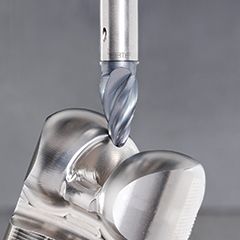Andrei Petrilin
Changes in barrel milling cutters have resulted in more flexible and versatile endmills
Endmills featuring a cutting edge that is actually the segment of a large diameter arc were introduced approximately 25 years ago. As the cutting edge shape of these endmills is reminiscent of a barrel profile, terms such as “barrel milling cutters,” “barrel endmills” or simply “barrels” soon became common when referring to these types of endmill. At first, the use of these barrel-shaped mills was limited more or less to a few specific applications, such as machining 3D surfaces of complex dies and turbomachinery components. However, advances in five axis machining and CAM systems have significantly expanded the boundaries of barrel endmill applications.
At the same time, the design principle of a cutting edge as the segment of a large diameter arc has been realized successfully in other types of milling cutters— the tools for high feed milling (HFM), also referred to as “fast feed” (FF) milling. The concept provides a toroidal cutting geometry that ensures productive rough machining at extremely high feed rates due to a chip thinning effect. Unlike high feed milling tools, barrel endmills are intended not for roughing but for finish and semi-finish machining of 3D surfaces with low stock removal.
Traditionally, ball nose and toroidal cutters perform these machining operations. However, the large diameter arc of the endmill cutting edge results in a substantial reduction of the cusp height generated between passes machined by a ball nose or toroidal cutter.Another advantage of this type of cutting edge is a significant increase in the distance between passes (a stepover or a stepdown, depending on the direction of a cutter displacement after every pass). This distance is at least five times larger without degradation of the surface finish parameters (see Fig. 1). This means that the number of passes and, subsequently, machining time is reduced. Increasing the distance between passes also improves tool life and diminishes tool-cost-per-part.
More Versatility
The classical barrel shape in endmills has undergone some changes to make these cutters more versatile. Combining a ball nose tip with peripheral large arc cutting edges creates a multi-purpose “cutting oval,” which facilitates the use of a barrel end mill as a ball nose milling tool.
 In taper endmills, transforming the profile of a major cutting edge into a large arc segment generates another cutting oval—a taper barrel. When compared with a common taper endmill, the taper barrel provides pinpoint contact between the major cutting edge and a machined surface that decreases accuracy errors and prevents recutting of a produced shape. The taper shape also contributes to reducing tool overhang, an important factor for improving tool performance.
In taper endmills, transforming the profile of a major cutting edge into a large arc segment generates another cutting oval—a taper barrel. When compared with a common taper endmill, the taper barrel provides pinpoint contact between the major cutting edge and a machined surface that decreases accuracy errors and prevents recutting of a produced shape. The taper shape also contributes to reducing tool overhang, an important factor for improving tool performance.
Barrel and oval endmills are mainly used for cutting side surfaces. When machining a complex bottom surface, a lens shape endmill is a good solution. This tool features barrel cutting edges on its end surface to ensure milling with a large stepover.
The barrel endmills, whether the classical barrel, oval or lens shaped cutters, provide efficient tools for machining 3D surfaces. Nevertheless, the complexity of CNC pro-gramming for applying barrel endmills has been a constraining factor in actively integrating these tools into several branches of the metalworking industry. The growing use of five axis machine tools and the latest progress in CAM software has changed that, and today we see intensive utilization of barrel endmills in manufacturing various parts with geometrically complex surfaces. The main consumers of these cutting barrels are producers of aerospace, die and mould, medicine, turbine and compressor components.
New Advances
Cutting tool companies in turn have strengthened their efforts to develop and manufacture more advanced barrel endmill designs to meet increased customer demands.
Cutters with a “no setup time” feature enable the replacement of a worn head without withdrawing a tool from the machine spindle. They can be particularly effective in the case of barrel tool applications in semi-finish and finish milling operations.
This is important because the complicated shape of a barrel endmill’s cutting edges mean the endmill is designed as a throwaway tool—when the wear limit is reached, the entire carbide endmill simply becomes waste.
At present, barrel milling cutters are not in incredibly high demand by the metalworking industry; they are intended for very specific parts and effective application of such cutters requires highly engineered multi-axis machines and leading edge CAM systems. However, advanced workpiece manufacturing technologies (such as metal injection moulding, 3D printing, investment casting and close tolerance forging), innovative machine tools, and a quantum leap in digitizing of manufacturing, will increase the needs for finishing complex surfaces with minimum machining stock.
Iscar’s specialists estimate that barrel endmill consumption in the metalworking industry will increase exponentially and cutting tool manufacturers should be shaping up to what is a promising new industrial trend. SMT
Andrei Petrilin is technical manager for Iscar Tools.
